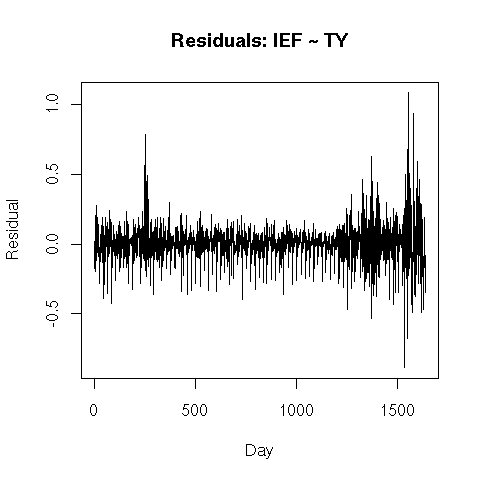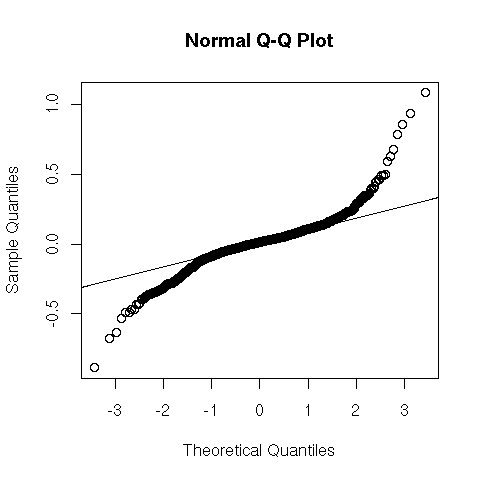A Spread Trade for IEF
DRAFT
Paul Teetor
Summary
The iShares
Barclays 7-10
Year Treasury Bond Fund (NYSE: IEF), is an exchange-traded fund
which holds primarily intermediate-term US
Treasury Notes. As the name suggests, the maturities of the
holdings range from 7 to 10 years.
I wanted to determine if IEF could be hedged or replicated using a
combination of Treasury futures. If so, it might be possible
to trade the spread between IEF and futures. I initially
modeled
the hedge/spread using Eurodollar, 2-year, 5-year, and
10-years futures.
The final model, however, required
only
the 10-year futures. Furthermore, the model residuals are
demonstrably
mean-reverting, which naturally leads to relative value trades.
This is very encouraging because it
suggests a simple spread -- IEF versus
10-year Treasury Note futures -- could be profitably traded.
Model Development
Full Model
The initial, full model was a time-series regression on the futures
prices using daily closing prices.
IEFi
= β0
+ βED×EDi
+ βTU×TUi
+ βFV×FVi
+ βTY×TYi
+ εi
εi
~ ARIMA(p,
1, q)
where
- ED
is Eurodollar futures
- TU
is the 2-year Treasury note futures
- FV
is the 5-year Treasury note futures, and
- TY
is the 10-year Treasury note futures.
The initial fit selected p
= 3 and q
= 4, giving an ARIMA(3,1,4) model for the residuals.
I assumed that the FV and
TY
futures would be necessary for modeling IEF
since the futures would, essentially, create a bar-bell portfolio which
matched the average maturity of the bond fund. I included ED
in case the ETF, which pays monthly dividends, was sensitive to
short-term rate movements. I included TU simply for completeness, without
expectation it would be a significant predictor.
Reduced Model
The TU
proved to be insignificant, which was not surprising. The ED
term was also insignificant, which was reasonable but a little
surprising.
I was quite surprised, however, that the FV
term was also insignificant. Evidently, the 10-year futures, TY,
is sufficient to mimic the fund behaviour without the 5-year bar-bell
component. The final, reduced model was
very simple:
IEFi
= β0
+ βTY×TYi
+ εi
εi
~ ARIMA(p,
1, q)
A re-fit of the ARIMA model gave p
= 1 and q
= 2, for a final ARIMA(1,1,2) model of ε. The
indicated
hedge ratio was approximately 1,308 shares of IEF for each TY contract.
Model Assessment
The model residuals are mostly clean and show no bias.
An obvious problem is the explosion in variance in the recent residuals
(extreme right-hand side). I assume this is caused by the
unprecedented conditions during the financial markets'
melt-down
of 2008. From a modeling standpoint, it suggests that the
market
has entered a new regime, and the model may require a local re-fit.
The variance explosion is echoed in the Normal quantile-quantile plot
of the residuals.
Clearly, there are out-sized residuals, as indicated by the fat tails.
This casts some suspicion on the model, but might be
explained by
the excessive market volatility of 2008.
Testing the residuals for mean reversion gives a p-value
of essentially zero, using
the Augmented Dickey-Fuller test, so we can be confident they are
mean-reverting. This is no surprise after seeing the
plot of
residuals, above.
Conclusions
The main result here is that the 10-year Treasury Note futures (TY)
seem sufficient for hedging the
IEF stock. This is a welcome result because the spread trade
is
quite simple and does not require a basket of futures contracts.
A second result is that the model's residuals are historically
mean reverting, creating the opportunity for mean-reversion trades:
the residuals act as indicators of over- and under-valuation,
letting us enter the spread at opportune times. This chart of
recent residuals
illustrates some typical opportunities.
Notice that the mispricing strayed from zero, but reliably returned to
the mean.
The extremes of those deviations represented trading
opportunities.
Limitations
This is only a preliminary study. A deeper study could
address
these issues, among others.
- The study used closing
prices, which are dissynchronized between
the futures market (3:00 PM Eastern) and the stock market (4:00 PM
Eastern). The unmatched closing times inevitably introduce
unwelcome noise into the model.
- The recent large
variance in the residuals needs further
research. Will a simple re-fit of the model to recent data
eliminate the excess variance, including the fat tails in the Q-Q
diagram?
- This study used Perpetual
Data® from Commodity Systems Inc.
for futures
prices. This is convenient for a quick study, but should
probably
be replaced by roll-forward data in order to improve the model's
credibility.
Acknowledgments
I am grateful to Art Margulis of Cognitive
Capital for suggesting the
idea of trading some ETFs as if they are fixed-income instruments.
I am also grateful to Mohamed Amezziane of DePaul University
for
his constructive comments on fitting the model.


